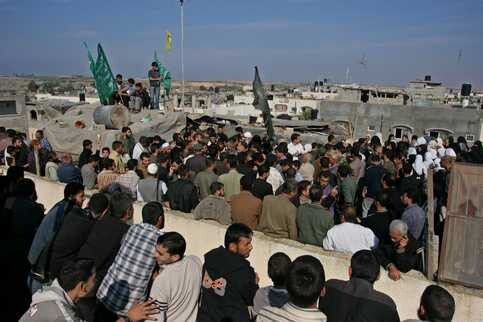Human Rights Watch 20 December 2006

Palestinians barricade themselves in and around the house of a Palestinian family in Beit Lahiya in the northern Gaza Strip, November 21, 2006, after they received a call from the Israeli military that they were going to blast the house and ordering its occupants to evacuate. (MaanImages/Wesam Saleh)
Human Rights Watch Statement on our November 22 Press Release
16 December - We regret that our press release below (“OPT: Civilians Must Not Be Used to Shield Homes Against Military Attacks”) gave many readers the impression that we were criticizing civilians for engaging in nonviolent resistance. This was not our intention. It is not the policy of the organization to criticize non-violent resistance or any other form of peaceful protest, including civilians defending their homes. Rather, our focus is on the behavior of public officials and military commanders because they have responsibilities under international law to protect civilians.
It has also become clear to us that we erred in assessing the main incident described in the press release. We said that the planned IDF attack on the house of a military commander in the Popular Resistance Committee, Muhammadwail Barud, fell within the purview of the law regulating the conduct of hostilities during armed conflict. We criticized Barud for reportedly urging civilians to assemble near the house in order to prevent the attack, in apparent violation of that law. Our focus was not on the civilians who assembled, their state of mind, or their behavior (such as whether they willingly assembled or not), but on Barud for risking the lives of civilians.
We have since concluded that we were wrong, on the basis of the available evidence, to characterize the IDF’s planned destruction of the house as an act of war. If the planned attack against the house - a three-story building housing three families - was, in fact, an administrative action by the Israeli government aimed at punishing a militant for his alleged activities, the law regulating the conduct of hostilities during armed conflict would not apply and could not be violated.
An important consideration in this regard is whether the IDF had reason to believe that the house was being used for military purposes at the time of the planned attack. To date, Human Rights Watch has not obtained conclusive evidence as to whether the house was being so used, but eyewitnesses we have been able to speak with, including two journalists on the scene, claim they saw no such evidence. The IDF, moreover, has not responded to our requests to explain what military objective it could have had in targeting not a militant but his home after having ordered it vacated.
We recognize that it is important to view the planned destruction of Barud’s house in light of Israel’s longstanding policy in the Occupied Palestinian Territories, sharply increased in Gaza since June, of demolishing houses not as legitimate military targets but as a punitive measure. HRW has repeatedly criticized Israel for unlawful demolition of houses.
Our intention in issuing this press release was to underscore one of the most fundamental principles of international humanitarian law: the obligation of warring parties to take all feasible measures to spare civilians from harm. This includes the important principle that parties to a conflict, including military leaders and civilian officials, may not use civilians to “shield” against a military attack or otherwise unnecessarily put civilian lives at risk. Unfortunately, judging by the response, we did more to cloud the issues than clarify them in the press release.
This continues to be a live issue in the Israeli-Palestinian armed conflict. In July 2006, Israeli and Palestinian human rights groups documented the IDF’s forcible use of Palestinians as human shields in a well publicized incident during military operations in Beit Hanoun. According to the groups, the IDF blindfolded six civilians, including two minors, and forced them to stand in front of soldiers who took over civilian homes during a raid in northern Gaza. And on November 3, Hamas militants hid behind civilian women when exiting from a mosque where the militants had been cornered by IDF forces after more than two days of fighting. The fact that the women voluntarily went to aid the men does not absolve the militants of their duty not to endanger civilians. Both of these cases took place in the course of armed conflict so that the laws of war did apply.
We invite readers to visit our website at www.hrw.org to see all that we have said on the conflict between Israel and the Palestinians. We continue to urge all parties to this conflict to respect international humanitarian law, whatever their share of its violations, and most important, to keep civilians out of it as much as possible.
Related Links